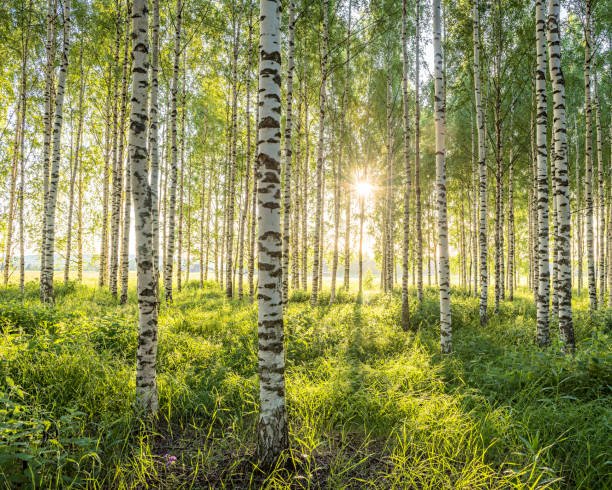If you’re a Michigan homeowner and wondering how to best care for birch trees Michigan, you’re not alone. Birch trees are among the most graceful and popular ornamental trees in the Great Lakes region. They are highly prized for their striking white or silver bark, delicate foliage, and the gentle shade they provide. However, despite their beauty and elegance, birch trees require a careful balance of conditions to remain healthy, particularly in Michigan’s variable climate. Understanding the species, soil requirements, watering needs, common pests, and diseases will help ensure your birch trees thrive for decades.
1. Common Birch Species in Michigan
Michigan is home to a variety of birch species, including both native species and some commonly planted ornamental varieties. These species have unique characteristics, which influence how they should be cared for. Knowing which type you have is crucial for providing the best maintenance.
-
Paper Birch (Betula papyrifera): This species is well-known for its iconic white, peeling bark and is often used as a statement tree in landscapes. Paper birches prefer well-drained, sandy or loamy soils and moderate moisture levels. They thrive in full sun but may struggle in overly hot or dry conditions.
-
Yellow Birch (Betula alleghaniensis): A slower-growing species, yellow birch prefers cool, moist, loamy soils and partial shade. Its golden bark adds beauty to shaded gardens, and it is valued for its durability in landscaping projects.
-
River Birch (Betula nigra): River birches are often found naturally near wetlands or rivers. They can tolerate wet soils and sometimes develop multiple stems, making them ideal for areas with poor drainage. River birches also offer visual appeal with their textured, peeling bark and bright green leaves.
-
Grey Birch (Betula populifolia): Grey birches are smaller, fast-growing trees that do well in dry, sandy soils. They often grow as multi-stemmed shrubs and are highly tolerant of urban conditions, including pollution and soil compaction.
-
Bog Birch: This species thrives in wet, peaty soils and is less commonly planted in residential yards. It is well-adapted to Michigan’s wetland areas but may require special soil conditions for successful cultivation.
Understanding the characteristics of these species will help homeowners select the right birch tree for their property and provide the care it needs to thrive.
2. Soil, Sunlight, and Water Needs
The health of birch trees in Michigan depends heavily on the growing conditions provided. Each species has unique soil, sunlight, and water requirements.
-
Sunlight: Most birch species thrive in full sunlight, which helps maintain vibrant foliage and healthy growth. Grey birch, in particular, requires ample sunlight to maintain its structure and leaf color. However, yellow birch may tolerate partial shade, which can help protect it from the hottest afternoon sun.
-
Soil: Soil preference varies by species. Paper birches prefer well-drained sandy or loamy soils, while river birches tolerate wetter areas and can even thrive in soils that remain damp for extended periods. Maintaining proper soil drainage and fertility is critical for preventing disease and promoting long-term growth.
-
Moisture: Water requirements also differ. River birches need consistently moist soil, while paper and grey birches can tolerate moderate moisture. Mulching around the root zone helps conserve soil moisture and regulate temperature, supporting tree health during dry periods.
-
pH Levels: Most birches prefer slightly acidic soil with a pH ranging from 5.0 to 7.0, depending on the species. Testing your soil periodically ensures optimal nutrient availability for your birch trees.
Providing the correct combination of sunlight, soil, and water will set the foundation for healthy growth and reduce the likelihood of stress-related issues.
3. Pests and Common Diseases
Birch trees, while resilient and beautiful, are susceptible to several pests and diseases that can significantly impact their health.
-
Bronze Birch Borer: This is one of the most destructive insects affecting birch trees. It bores into the bark, disrupting nutrient flow and weakening the tree, often resulting in death if not treated promptly. Stress factors such as drought or improper planting increase vulnerability.
-
Birch Leafminer: A common pest, the birch leafminer causes browning and curling of leaves, usually appearing in late spring or early summer. While minor infestations may not be fatal, repeated attacks can weaken the tree over time.
-
Aphids and Sooty Mold: Aphids extract sap from leaves and branches, secreting a sticky substance called honeydew that encourages sooty mold growth. This mold can cover leaves and reduce photosynthesis, weakening the tree.
-
Leaf Spot Diseases: Fungal pathogens such as Septoria and anthracnose cause leaf spotting, discoloration, and premature leaf drop. While not always fatal, these diseases reduce the tree’s aesthetic appeal and overall health.
-
Cankers: Sunken or dead bark areas can be caused by fungal infection. Cankers restrict nutrient flow and create entry points for pests and secondary diseases, making prevention critical.
Regular monitoring, early detection, and proper care can minimize the impact of pests and diseases on birch trees.
4. Maintenance and Care Tips
Proper maintenance is essential for the health and longevity of birch trees in Michigan. Here are several strategies homeowners should adopt:
-
Consistent Watering: Newly planted birches require regular watering to establish strong root systems. Even mature trees benefit from supplemental watering during dry spells, especially river birches and other moisture-loving species.
-
Mulching: A two- to three-inch layer of organic mulch around the tree base helps retain soil moisture, moderate temperature, and reduce weed competition. Keep mulch a few inches away from the trunk to prevent rot.
-
Pruning: Pruning should be done during the dormant season to remove dead, diseased, or damaged branches. Proper pruning enhances airflow, reduces disease risk, and maintains a desirable shape. Avoid excessive pruning, which can stress the tree.
-
Pest Monitoring: Watch for early signs of leafminer damage, aphid infestations, and bronze birch borer activity. Prompt treatment can prevent significant tree decline.
-
Soil and Nutrient Management: Testing soil periodically allows you to adjust pH levels and nutrient availability. Fertilization may be needed in nutrient-deficient soils to maintain healthy growth.
Maintaining birch trees with these best practices will promote resilience against environmental stressors and pests.
5. When to Call a Professional
Caring for birch trees can be challenging, especially if they show signs of severe stress, pest infestation, or disease. Homeowners who are uncertain about proper care or lack the tools for safe pruning should consult a professional arborist. Experts can assess tree health, recommend treatment plans, and perform necessary interventions safely and effectively.
Longtree Tree Service provides professional arborist services in Michigan, including tree health assessments, pruning, disease management, and pest control. Their trained arborists understand the unique requirements of birch trees in Michigan’s climate and can provide customized solutions for homeowners.
Conclusion
Birch trees are a stunning addition to Michigan landscapes, offering beauty, shade, and a unique aesthetic with their distinctive bark. However, they require careful attention to thrive, from selecting the appropriate species for your property to providing proper soil, sunlight, water, and maintenance. Understanding the common pests and diseases that affect birches is crucial to keeping them healthy and ensuring their longevity. For Michigan homeowners seeking expert guidance, professional services from Longtree Tree Service can make all the difference. Their team of experienced arborists specializes in birch tree care, helping your trees flourish for many years to come.
visit: zynrewards




Leave a Reply